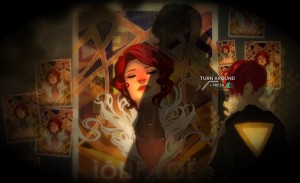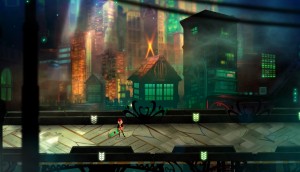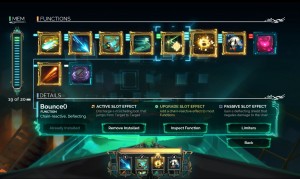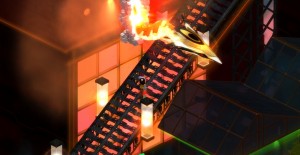A Gameplay Analysis of Transistor
By Julie Morley
[divider]Transistor is our August 2014 “Not Crowdfunded, But…” title. For more Transistor content head over here.
[divider] [dropcap]F[/dropcap]irst of all, I want to begin this article with the most enthusiastic expression of joy and completeness, as well as some intense emphasis on the emotional exhaustion, this beautifully constructed game bestowed upon me. I thought the foundation that is my worldly understanding was solid. But when Transistor entered my life, oh boy, it was shaken.Normally when I begin with a dramatic introduction, I joke about what a nut job I am, but in this case, I mean it. And if you invested $19.99 (or $29.98 if you would fancy the soundtrack with it) on Steam for Transistor, you’d know exactly what I mean. But the journey of Transistor, story-wise, is to be covered by a different Cliqist journalist. For me, it’s time to break down the gameplay of this puppy.
A Little Bit of Background
 Transistor is an isometric action adventure RPG that takes place in a gorgeous futuristic metropolis with an authoritarian group’s (Catarina) latest attempt at saving the city’s populace has gone awry. Horribly awry. A famous musician, Red, has lost her voice and a loved one in the midst of the chaos engulfing Cloudbank. Upon discovering his body, she finds a strange weapon, named the Transistor – its origin unknown. The Transistor unlike any other weapon, it has personality and will adopt any stray souls wandering about. Conveniently, Red’s partner is one of them.
Transistor is an isometric action adventure RPG that takes place in a gorgeous futuristic metropolis with an authoritarian group’s (Catarina) latest attempt at saving the city’s populace has gone awry. Horribly awry. A famous musician, Red, has lost her voice and a loved one in the midst of the chaos engulfing Cloudbank. Upon discovering his body, she finds a strange weapon, named the Transistor – its origin unknown. The Transistor unlike any other weapon, it has personality and will adopt any stray souls wandering about. Conveniently, Red’s partner is one of them.
Level Design and Atmosphere
 As for the level and environmental design, I’m unsure where to begin. We are in a cyberpunk-esque futuristic cosmopolitan paradise, composed of stunning hand painted environments that are jaw dropping in itself. Supergiant Games defines atmosphere with Transistor’s environment, each section transitioning in style, tone, and color in such a subtle and beautiful manner, players are wooed into this world instantaneously. Transistor’s immersion is top notch and one of the best I’ve seen in all the indie games I’ve played. I cannot stress enough how breathtaking the visuals are. But more on those later.
As for the level and environmental design, I’m unsure where to begin. We are in a cyberpunk-esque futuristic cosmopolitan paradise, composed of stunning hand painted environments that are jaw dropping in itself. Supergiant Games defines atmosphere with Transistor’s environment, each section transitioning in style, tone, and color in such a subtle and beautiful manner, players are wooed into this world instantaneously. Transistor’s immersion is top notch and one of the best I’ve seen in all the indie games I’ve played. I cannot stress enough how breathtaking the visuals are. But more on those later.
 It’s the tiny details that count and that’s what presented a sense of realism and immersion in this case. Red is carrying the Transistor all across Cloudbank, trying to get answers for what’s going on. Along the way, she discovers crime scenes and terminals – containing updates about Cloudbanks events, taking polls about the citizen’s weather and sky color of choice, and even vote on Pizza options. With the news updates and personal messages received through the terminal, an intriguing story began to unfold. With these elements, the world of Transistor became very real, and in peril.
It’s the tiny details that count and that’s what presented a sense of realism and immersion in this case. Red is carrying the Transistor all across Cloudbank, trying to get answers for what’s going on. Along the way, she discovers crime scenes and terminals – containing updates about Cloudbanks events, taking polls about the citizen’s weather and sky color of choice, and even vote on Pizza options. With the news updates and personal messages received through the terminal, an intriguing story began to unfold. With these elements, the world of Transistor became very real, and in peril.
Level/environment organization is easy to follow but gives the player the impression of the freedom to explore. Each area has confines restricting the player from exploring further (whether it is a group of enemies or a doorway) but the multiple planes and elaborate pathways to venture off to give not only a more realistic sense of the city of Cloudbank but a feeling the player is actually discovering every nook and cranny of the metropolis themselves. This further grants a great sense of immersion.
It’s Go Time – Combat System and Enemies
 The Process, endearing robotic enemies who will stop at nothing to take Red down, is the enemy we spend the majority of Transistor combating. These foes are spread all throughout Cloudbank and we unavoidably cross their path frequently. Early on, a system of exploration and fighting is established. Every time Red enters a combat area, an inescapable perimeter appears, forcing Red to engage in battle with the process.
The Process, endearing robotic enemies who will stop at nothing to take Red down, is the enemy we spend the majority of Transistor combating. These foes are spread all throughout Cloudbank and we unavoidably cross their path frequently. Early on, a system of exploration and fighting is established. Every time Red enters a combat area, an inescapable perimeter appears, forcing Red to engage in battle with the process.
The Transistor is a force to be reckoned with – a weapon full of surprises and unnatural abilities. A huge portion of the combat in Transistor relies on strategy and planning. The Transistor allows Red to pause and slow time to execute a series of planned moves. As for moves, we have four skill slots, each with two potential passive ability slots. The Transistor’s abilities range from cloaking, manipulating the process, asking for help, or offensive forces. At each checkpoint, we can combine abilities, with the limitation of a system point count, to create increasingly powerful combo skills. When the Process manage to knock down a significant portion of Red’s health, she overloads one of her abilities, granting her four lives.
 At the conclusion of each battle, players accumulate XP and level up. With these levels, players earn upgrades and additional abilities. With the use of limiters, players increase the difficulty of combat, giving the Process an advantage but acquire more XP.
At the conclusion of each battle, players accumulate XP and level up. With these levels, players earn upgrades and additional abilities. With the use of limiters, players increase the difficulty of combat, giving the Process an advantage but acquire more XP.
At certain points of Transistor backdoors to an island filled with miscellaneous doors to tests and training levels will open up. Here, we are actually taught more about time management and improve the use of halting time amidst the fighting. Not only is it an attractive (and comforting) change of scenery for the player (and Red), but it gives the player a greater understanding of the Process’s weaknesses.
 As for boss battles, Transistor is loaded with them and they only get worse the further we progress. The closer Red is to the tower of interest, the more challenging each boss battle becomes – to the point we are fighting the spine of a disgustingly awesome serpentine creature lurking in Cloudbank and even the creator of the Transistor themselves. The gradation of difficulty, however, is steady and feels natural for the player – providing the sense of flow and improvement.
As for boss battles, Transistor is loaded with them and they only get worse the further we progress. The closer Red is to the tower of interest, the more challenging each boss battle becomes – to the point we are fighting the spine of a disgustingly awesome serpentine creature lurking in Cloudbank and even the creator of the Transistor themselves. The gradation of difficulty, however, is steady and feels natural for the player – providing the sense of flow and improvement.
In Conclusion
Transistor’s game design is impressive to say the least. Though elaborate, it is organized in a natural flow of events and difficultly, allowing the player to completely immerse themselves. And with that, I tip my hat to you, Supergiant Games. Transistor has been one of the most challenging, beautiful, and engaging games I have ever had the pleasure to play. My expectations weren’t just met, they were crushed to a pulp.
[divider][Google][pinterest][follow id=”Cliqist” size=”large” count=”true” ]
[author image=”http://cliqist.com/wp-content/uploads/2014/01/julie.jpg” ]Julie Morley is a freelance writer and comic artist from Spring, Texas. She attended the Academy of Art University for two years, studying Animation and Illustration. Whilst here, she learned about writing comic scripts, storyboards, and general storytelling. Since leaving college, she has been working on personal comic projects, stories, and illustrations. She aspires to release a self published comic within two years. For the majority of her life, she has been playing console games, typically being third-person shooters and sandboxes. Her favorite game of existence is Dark Cloud II (Dark Chronicle) and her favorite Indie game is Gone Home.[/author]





[…] 8/21 – Transistor Gameplay Analysis […]
[…] Even if you don’t like action RPG’s, you should really try Transistor, because the art style, the story and the music are amazing. I’m not going to go into all those things because we already have, […]